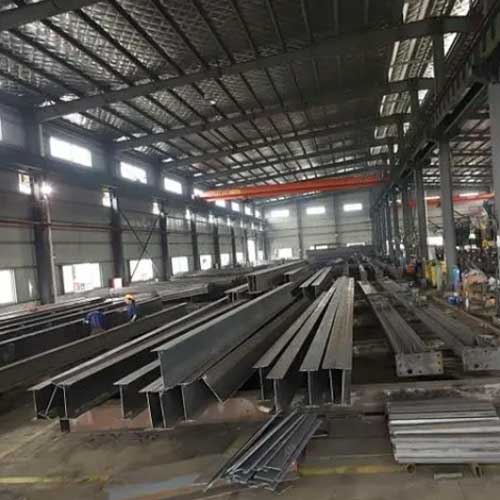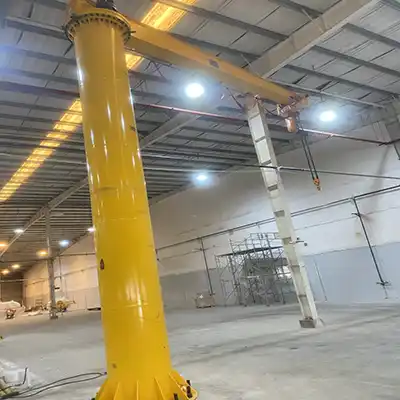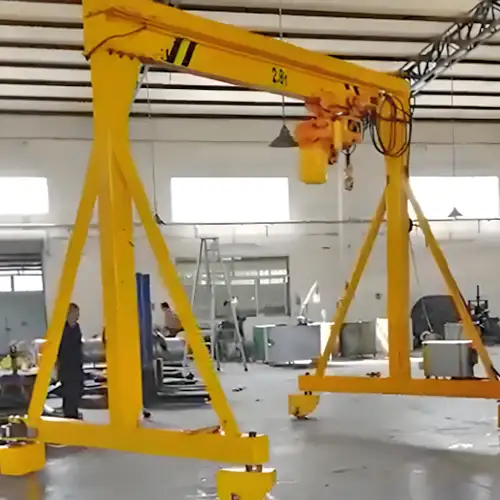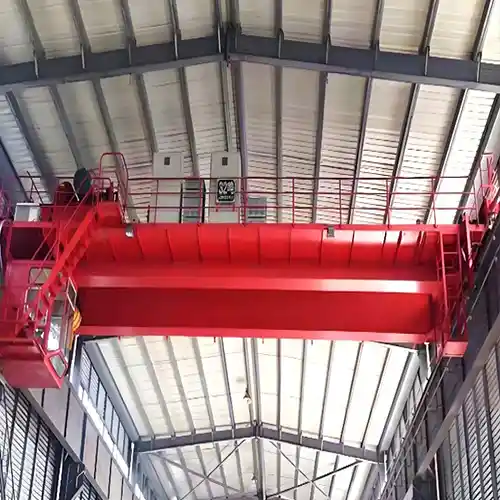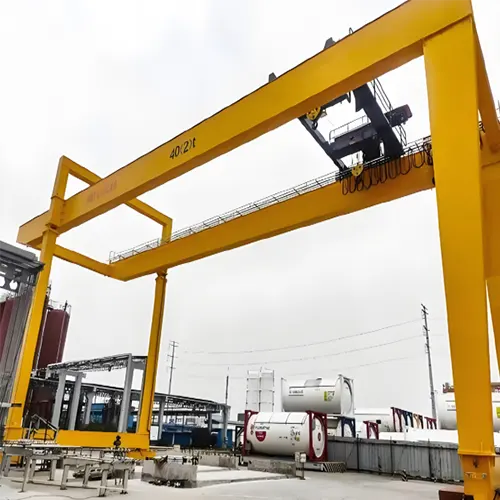Overhead Cranes & Gantry Cranes for Steel Structure Handling
Steel Structure Handling Overhead Cranes for Sale. Comprehensive Guide on Applications & Selection in Different Steel Building Construction.Get your overhead crane!
Category: Construction
Your Trusted Overhead Crane Manufacturer & Supplier
Overhead Cranes & Gantry Cranes for Steel Structure Handling
Elevating Construction Excellence: A Comprehensive Guide to Steel Structure Handling Overhead Cranes
Overhead Cranes and Gantry Cranes for Steel Structure Handling Overview on Applications & Selection in Different Steel Building Construction.Get your overhead crane!
Overview of Steel Structure Handling Overhead Cranes
In the dynamic world of construction, efficiency and precision are paramount. Among the myriad tools and technologies that have transformed the industry, Steel Structure Handling Overhead Cranes stand out as indispensable workhorses. These powerful machines have become the backbone of modern construction, facilitating the seamless movement and installation of steel structures with unparalleled accuracy.
Overhead cranes, with their various configurations, have evolved to meet the demands of handling diverse steel components, from heavy trusses to delicate prefabricated modules. Understanding the nuances of these cranes is essential for construction professionals aiming to optimize their building processes.
The importance of overhead cranes in building construction cannot be overstated. These mechanical marvels play a pivotal role in lifting, moving, and placing steel structures with remarkable efficiency. As the construction industry increasingly embraces steel for its strength, durability, and versatility, the need for specialized equipment like overhead cranes becomes paramount.
Whether it's the assembly of prefabricated modules, the installation of intricate steel pipelines, or the precise positioning of steel staircases, overhead cranes serve as the backbone of a project's success. Their ability to navigate confined spaces, lift heavy loads, and operate with precision makes them invaluable assets on construction sites of all scales.
Overhead Cranes in Steel Structure Manufacturing
In the intricate dance of steel structure manufacturing, Overhead Cranes take center stage, seamlessly lifting, moving, and placing hefty steel components with precision. These mechanical workhorses operate in diverse settings, from bustling fabrication workshops to outdoor material storage yards. In steel manufacturing plants, they navigate through casting areas, ensuring a smooth flow of materials.
As the construction act begins, Overhead Cranes gracefully move into assembly lines, orchestrating the installation and alignment of steel components. Beyond the physical realm, these cranes embrace technology and automation, enhancing their efficiency. Safety is paramount, with built-in features adhering to industry regulations, ensuring a secure manufacturing environment.
In the grand finale of real estate development, Overhead Cranes return to the construction stage, installing steel components that define skylines. These cranes, with varied capacities, bring blueprints to life, shaping the structural framework of our modern world. In every move, Overhead Cranes elevate steel structure manufacturing to an art form, a ballet of efficiency that leaves an indelible mark on the built environment.
- Bridge Cranes -Bridge cranes, also known as overhead traveling cranes, are a ubiquitous presence in construction. Their design involves a horizontal beam (bridge) that traverses along elevated runways supported by vertical columns. These cranes are versatile, offering a broad range of applications in the movement of heavy steel structures.
- Gantry Cranes -Gantry cranes operate on a similar principle as bridge cranes but differ in their support structure. Supported by legs on the ground, gantry cranes can move on rails. Their ground level support makes them ideal for outdoor construction sites where overhead support might be impractical.
- Jib Cranes -Jib cranes are characterized by a horizontal jib or boom attached to a vertical support. These cranes are instrumental in handling steel components within confined spaces. Their precision and maneuverability make them ideal for tasks such as positioning and erecting steel columns.
- Double Girder Cranes -Double girder cranes feature two horizontal girders that support the lifting mechanism. These cranes excel in heavy duty applications, providing increased lifting capacity. They are a reliable choice for handling large and weighty steel components during construction.
- Single Girder Cranes -Single girder cranes, with a single horizontal girder, are lighter and more cost effective than their double girder counterparts. They are suitable for smaller loads and spans, making them an efficient choice for handling smaller steel components with agility.
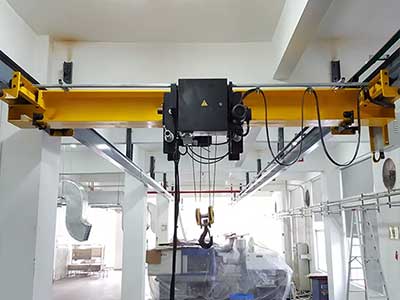
Bridge Cranes:
Overhead Cranes for Steel Structure Manufacturing and Handling:
Essential for lifting and moving heavy loads horizontally across the width of a facility.
Crane Design & Capacities:
Varied configurations with load capacities ranging from a few tons to several hundred tons.
Tailored Features for Operation:
Dual girder design for stability, precise controls for accurate positioning.
Applicable Industries:
Steel fabrication workshops, manufacturing plants, construction sites.
Typical Crane Project Location in Workshop:
Positioned centrally to cover the entire workshop floor.
Typical Loads or Objects:
Large steel structures, prefabricated modules, machinery components.
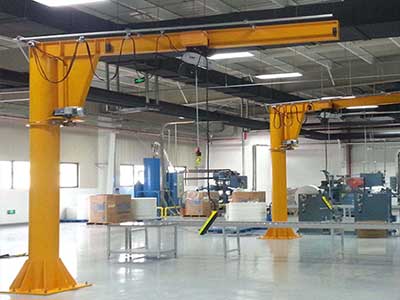
Jib Cranes:
Overhead Cranes for Steel Structure Manufacturing and Handling:
Designed for localized lifting and maneuvering, suitable for specific workstations.
Crane Design & Capacities:
Compact with load capacities ranging from a few hundred pounds to several tons.
Tailored Features for Operation:
Rotation capabilities for versatile coverage within a designated area.
Applicable Industries:
Workstations in steel fabrication workshops, assembly lines.
Typical Crane Project Location in Workshop:
Installed at specific workstations or assembly points.
Typical Loads or Objects:
Small to medium sized components, tools, welding equipment.
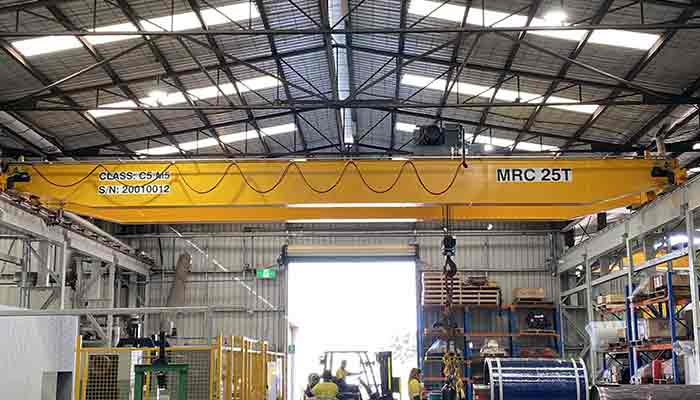
Double Girder Cranes:
Overhead Cranes for Steel Structure Manufacturing and Handling:
High capacity cranes designed for heavy lifting and precise control.
Crane Design & Capacities:
Dual girder design for increased stability, capable of handling extremely heavy loads.
Tailored Features for Operation:
Enhanced lifting height, advanced control systems for precision.
Applicable Industries:
Steel manufacturing plants, large scale fabrication facilities.
Typical Crane Project Location in Workshop:
Centrally positioned for maximum coverage and efficiency.
Typical Loads or Objects:
Heavy steel beams, large machinery components, steel coils.
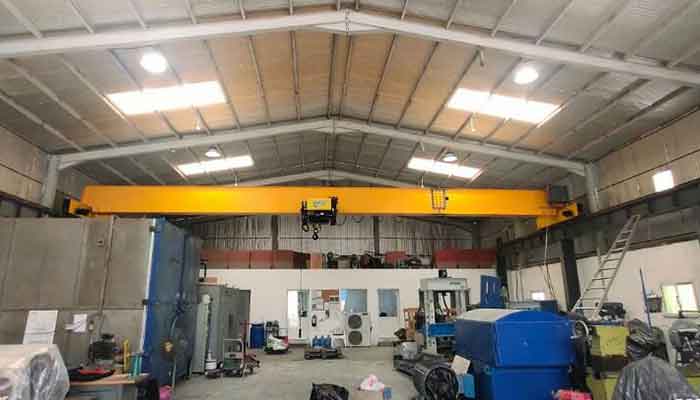
Single Girder Cranes:
Overhead Cranes for Steel Structure Manufacturing and Handling:
Versatile cranes suitable for medium to heavy lifting tasks.
Crane Design & Capacities:
Single girder design with load capacities ranging from a few tons to moderate loads.
Tailored Features for Operation:
Compact design, cost effective, suitable for various applications.
Applicable Industries:
Steel fabrication workshops, assembly lines, small to medium scale manufacturing.
Typical Crane Project Location in Workshop:
Positioned strategically based on the layout of the workshop.
Typical Loads or Objects:
Steel trusses, fabricated components, machinery parts.
Gantry Cranes in Steel Structure Manufacturing
In the realm of steel structure manufacturing, where precision and strength harmonize, Gantry Cranes emerge as stalwart performers. These towering structures, also known as Goliath Gantry Cranes, command attention as they span vast areas of workshops and fabrication yards. Their unique design, characterized by horizontal beams supported by vertical legs, grants them unparalleled versatility in handling heavy loads with grace.
The essence of Gantry Cranes lies in their ability to bridge the gap between fixed overhead cranes and mobile solutions. With their capacity to traverse along rails or tracks, they bring the operation to the heart of the action. In steel fabrication workshops, where the clatter of machinery and welding stations reverberates, Gantry Cranes take center stage. Their horizontal mobility allows for the efficient movement of steel beams and large structures, contributing to the choreography of steel components coming together.
One of the distinguishing features of Goliath Gantry Cranes is their outdoor prowess. Unlike their overhead counterparts confined to workshops, Gantry Cranes venture into material storage yards with ease. Here, they navigate the open space, lifting and transporting raw materials, optimizing storage, and facilitating organized shipping activities. The yard transforms into an organized expanse where steel components await their turn in the manufacturing process.
As essential players in the steel manufacturing process, Gantry Cranes are strategically positioned to handle large and heavy components. In the orchestration of casting areas and diverse manufacturing processes, these cranes become indispensable. Their vertical legs provide stability, allowing them to hoist steel coils and navigate through intricate stages of steel transformation.
Beyond their physical prowess, Gantry Cranes bring adaptability to the forefront. Their designs cater to diverse needs, from single leg gantry cranes ideal for confined spaces to double leg gantry cranes offering enhanced stability for heavier loads. The marriage of strength and flexibility makes them instrumental in the seamless flow of materials within the manufacturing landscape.
In the grand ballet of construction and engineering, Gantry Cranes make a mark by contributing to the precise installation and alignment of steel components. Their ability to traverse the length of assembly lines ensures that steel structures are meticulously pieced together. Whether in the controlled environment of workshops or the expansive setting of construction sites, Gantry Cranes stand as guardians of efficiency, embodying the strength required to shape the skeleton of our architectural landscape.
In conclusion, Gantry Cranes, especially the commanding Goliath Gantry Cranes, play a vital role in the symphony of steel structure manufacturing. With their dynamic mobility, outdoor prowess, and adaptability, these cranes become integral partners in the choreographed dance of transforming raw steel into the architectural marvels that define our modern world.
Overview of Gantry Cranes in Steel Structure Manufacturing and Handling
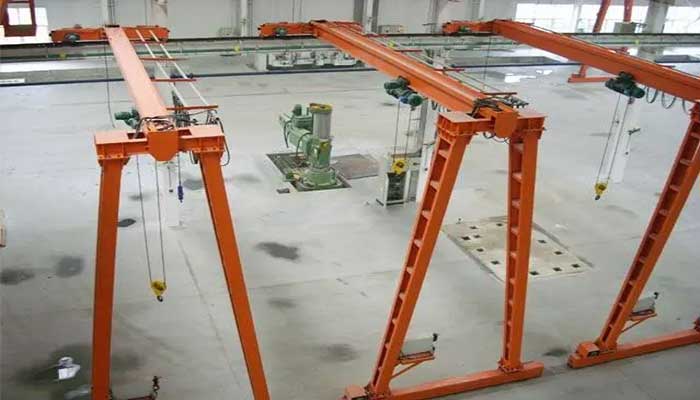
Single Leg Gantry Cranes:
Gantry Cranes for Steel Structure Manufacturing and Handling:
Designed with a single supporting leg for increased flexibility and reduced obstruction.
Crane Design & Capacities:
Various load capacities ranging from light to heavy, depending on the specific design.
Tailored Features for Operation:
Suitable for confined spaces, cost effective, and adaptable to specific workshop layouts.
Applicable Industries:
Workshops with limited space, outdoor material handling.
Typical Crane Project Location in Workshop:
Positioned to maximize coverage while minimizing interference with other equipment.
Typical Loads or Objects:
Small to medium sized components, materials, and fabricated structures.
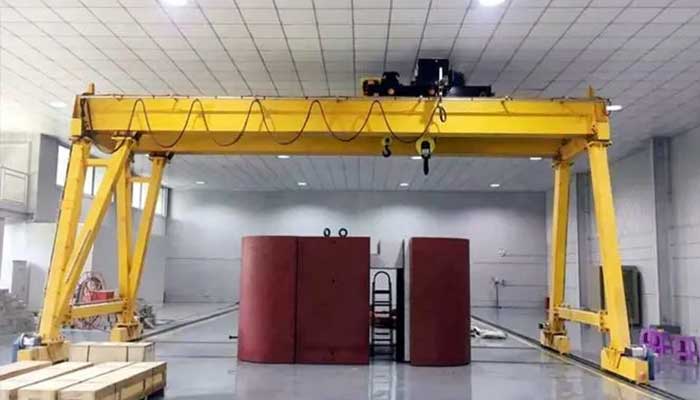
Double Leg Gantry Cranes:
Gantry Cranes for Steel Structure Manufacturing and Handling:
Sturdier design with two supporting legs for increased stability and load capacity.
Crane Design & Capacities:
Higher load capacities compared to single leg gantry cranes, suitable for heavier tasks.
Tailored Features for Operation:
Enhanced stability, precise controls, adaptable to various load types.
Applicable Industries:
Heavy steel fabrication, construction sites with demanding lifting requirements.
Typical Crane Project Location in Workshop:
Centrally positioned to cover a larger area and handle heavier loads.
Typical Loads or Objects:
Large steel structures, machinery components, and heavy materials.
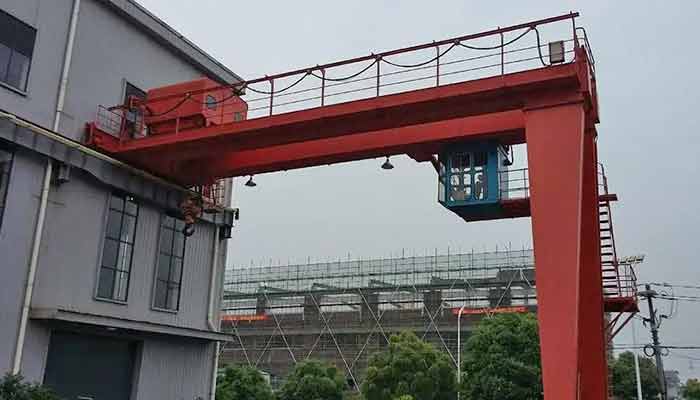
Semi Gantry Crane:
Gantry Cranes for Steel Structure Manufacturing and Handling:
Combines features of both bridge and gantry cranes, with one end supported on wheels and the other end on a runway.
Crane Design & Capacities:
Moderate to high load capacities, depending on the specific design.
Tailored Features for Operation:
Suitable for handling loads along a linear path, providing versatility.
Applicable Industries:
Workshops with specific linear material handling requirements.
Typical Crane Project Location in Workshop:
Positioned along the linear path of material flow.
Typical Loads or Objects:
Varied, depending on the specific linear material handling needs.
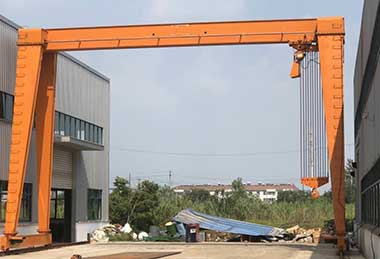
Full Gantry Crane:
Gantry Cranes for Steel Structure Manufacturing and Handling:
Fully supported on a runway structure, providing stability and increased load capacity.
Crane Design & Capacities:
High load capacities, suitable for heavy duty material handling tasks.
Tailored Features for Operation:
Robust design, precise controls, suitable for demanding applications.
Applicable Industries:
Large scale steel manufacturing plants, heavy construction projects.
Typical Crane Project Location in Workshop:
Positioned strategically for maximum coverage and efficiency.
Typical Loads or Objects:
Heavy steel beams, large fabricated structures, and machinery components.
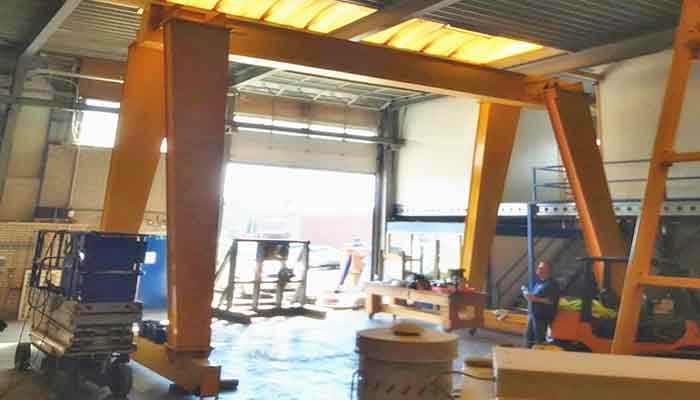
Single Girder Gantry Crane:
Gantry Cranes for Steel Structure Manufacturing and Handling:
Utilizes a single girder for overhead lifting and horizontal movement.
Crane Design & Capacities:
Moderate load capacities suitable for various applications in steel structure handling.
Tailored Features for Operation:
Compact design, cost effective, adaptable to different workshop setups.
Applicable Industries:
Steel fabrication workshops, assembly lines, small to medium scale manufacturing.
Typical Crane Project Location in Workshop:
Positioned based on the layout and requirements of the workshop.
Typical Loads or Objects:
Steel trusses, fabricated components, machinery parts.
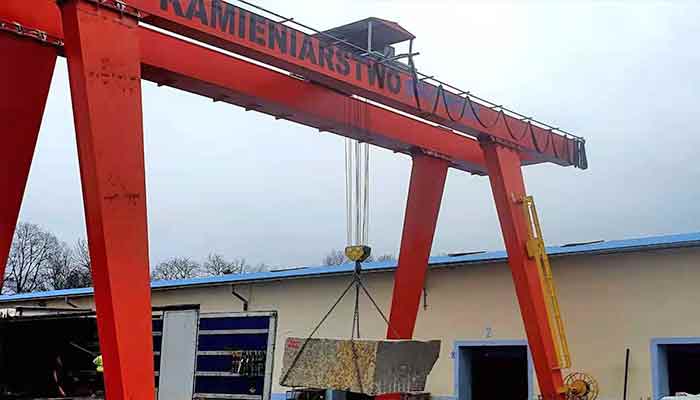
Double Girder Gantry Crane:
Gantry Cranes for Steel Structure Manufacturing and Handling:
Features two girders for increased stability and higher load capacities.
Crane Design & Capacities:
High load capacities suitable for heavy lifting tasks in steel structure manufacturing.
Tailored Features for Operation:
Enhanced stability, precise controls, optimal for handling large and heavy loads.
Applicable Industries:
Steel manufacturing plants, large scale fabrication facilities.
Typical Crane Project Location in Workshop:
Centrally positioned for maximum coverage and efficiency.
Typical Loads or Objects:
Heavy steel beams, large machinery components, steel coils.

Outdoor Gantry Crane:
Gantry Cranes for Steel Structure Manufacturing and Handling:
Specifically designed to operate in outdoor environments, offering versatility and mobility.
Crane Design & Capacities:
Varied load capacities suitable for handling materials in outdoor yards.
Tailored Features for Operation:
Weather resistant design, mobility for outdoor material handling.
Applicable Industries:
Outdoor material storage yards, construction sites with open spaces.
Typical Crane Project Location in Workshop:
Positioned in outdoor yards for handling materials in open environments.
Typical Loads or Objects:
Large steel components, materials, and structures in outdoor settings.

Indoor Gantry Crane:
Gantry Cranes for Steel Structure Manufacturing and Handling:
Designed for operation within indoor facilities, optimizing material handling in confined spaces.
Crane Design & Capacities:
Varied load capacities suitable for indoor material handling requirements.
Tailored Features for Operation:
Compact design, precise controls, suitable for indoor workshops.
Applicable Industries:
Indoor steel fabrication workshops, manufacturing plants with limited space.
Typical Crane Project Location in Workshop:
Positioned strategically within indoor spaces based on workflow requirements.
Typical Loads or Objects:
Electric Hoists in Steel Structure Manufacturing
In the steel structure manufacturing, where precision meets efficiency, Electric Hoists emerge as nimble performers. These compact yet powerful devices play a pivotal role in the controlled lifting and precise positioning of steel components, adding finesse to the robust processes within workshops and fabrication plants.
Electric Hoists, characterized by their compact design and efficient vertical lifting capabilities, are the unsung heroes of steel manufacturing. Unlike their larger counterparts, such as Overhead and Gantry Cranes, electric hoists provide a more localized solution. With a focus on controlled lifting, these devices bring a level of detail and finesse to the handling of steel beams, trusses, and various fabricated components.
One of the key advantages of electric hoists lies in their versatility and adaptability. Equipped with wire ropes or chains, these hoists effortlessly navigate through the open spaces of steel fabrication workshops. Their ability to lift loads vertically and move them horizontally within a confined area contributes to the intricate workflow of assembling steel structures.
In steel manufacturing plants, where heavy machinery processes raw steel into usable components, electric hoists find their niche. Positioned strategically within the manufacturing landscape, these hoists handle the precise transportation of steel coils and other materials. Their contribution to the early stages of steel processing ensures a seamless flow of raw materials, setting the stage for subsequent manufacturing processes.
The integration of electric hoists into workstation areas enhances the precision required in modular construction and assembly tasks. Their controlled lifting mechanisms make them indispensable for positioning modular components with accuracy. This level of detail becomes crucial in prefabrication plants, where the assembly of modular structures demands meticulous handling.
Beyond their physical attributes, electric hoists are designed to meet safety standards and compliance. With features like overload protection and emergency braking systems, they provide a secure environment for steel structure manufacturing. This commitment to safety aligns with the industry's emphasis on creating workspaces that prioritize the well-being of workers and the integrity of the manufacturing process.
In essence, electric hoists represent the finesse in the orchestra of steel structure manufacturing. Their compact design, versatility, and precision make them indispensable in handling the intricacies of steel components. Whether lifting heavy machinery components on assembly lines or delicately positioning prefabricated modules, electric hoists weave through the manufacturing landscape with a level of detail that complements the robust processes shaping our architectural landscape.
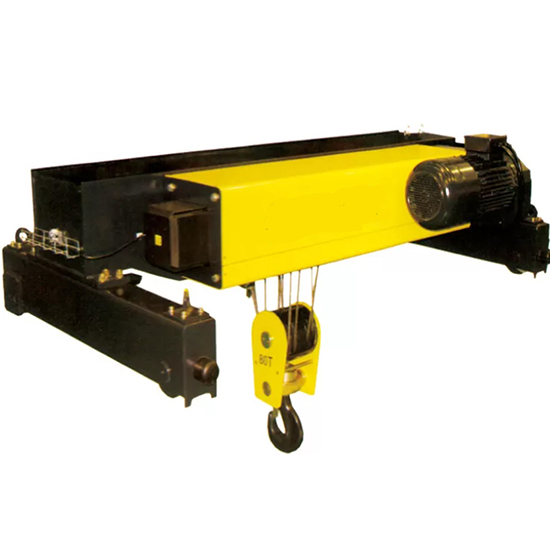
Wire Rope Electric Hoists:
Hoists for Steel Structure Manufacturing and Handling:
Utilizes a wire rope for lifting and lowering heavy loads in steel structure applications.
Hoist Design & Capacities:
Varied capacities to handle a range of loads, from light to heavy in steel fabrication.
Tailored Features for Operation:
Robust wire rope construction, multiple lifting speeds, suitable for heavy duty tasks.
Applicable Industries:
Steel manufacturing plants, fabrication workshops, construction sites.
Typical Hoist Project Location in Workshop:
Positioned on bridge cranes or gantry cranes for overhead material handling.
Typical Loads or Objects:
Heavy steel beams, fabricated components, machinery parts.
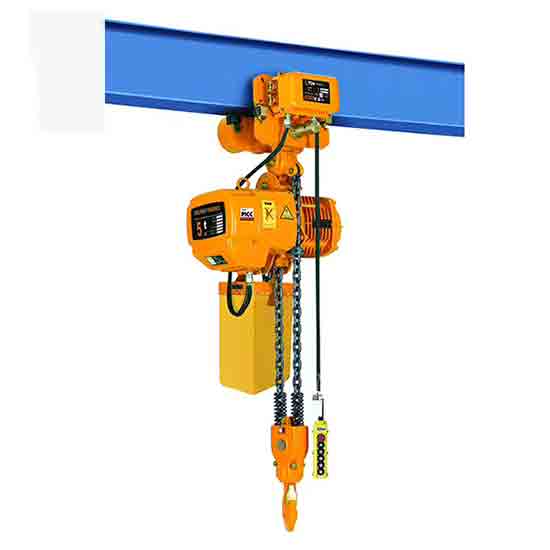
Electric Chain Hoists:
Hoists for Steel Structure Manufacturing and Handling:
Utilizes a chain mechanism for lifting and lowering loads, providing versatility.
Hoist Design & Capacities:
Compact design with varying load capacities, suitable for a wide range of applications.
Tailored Features for Operation:
Lightweight and easy to maneuver, ideal for precise positioning of loads.
Applicable Industries:
Workshops with diverse lifting requirements, assembly lines, material handling.
Typical Hoist Project Location in Workshop:
Installed on jib cranes, workstation cranes, or used as standalone units.
Typical Loads or Objects:
Small to medium sized components, materials, and products in steel fabrication.
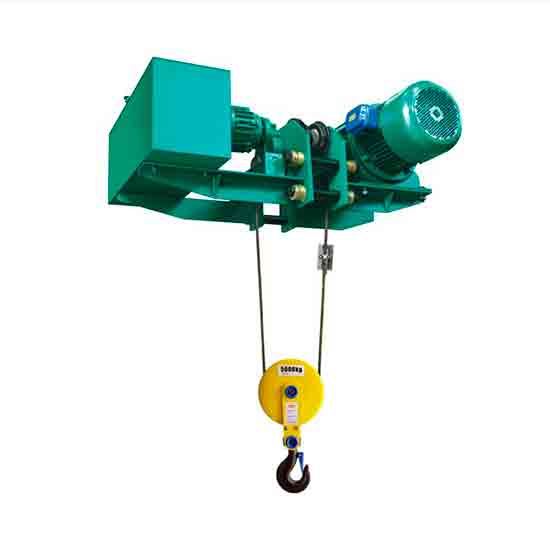
Low Headroom Wire Rope Hoist:
Hoists for Steel Structure Manufacturing and Handling:
Specifically designed for limited vertical space, allowing for optimal use of headroom.
Hoist Design & Capacities:
Compact design with wire rope construction, tailored for low headroom applications.
Tailored Features for Operation:
Minimal space requirements, suitable for applications with height restrictions.
Applicable Industries:
Workshops or facilities with limited vertical clearance for overhead lifting.
Typical Hoist Project Location in Workshop:
Positioned on bridge cranes or gantry cranes where vertical space is constrained.
Typical Loads or Objects:
Heavy components, machinery parts, or materials in areas with low headroom.
Material Handling of Overhead Cranes in Steel Structure Manufacturing Workshops
In the dynamic realm of steel structure manufacturing, where precision and efficiency are paramount, the orchestration of heavy steel components often relies on the robust shoulders of overhead cranes. These engineering marvels, capable of lifting and transporting substantial loads with finesse, play a central role in the diverse workshops dedicated to shaping the steel structures that define our industrial landscape.
Within the expansive expanse of steel fabrication workshops, equipped with heavy-duty machinery and welding stations, overhead cranes stand tall as the workhorses of material handling. These workshops, characterized by their large open spaces conducive to the fabrication of steel components, strategically position overhead cranes to lift and move heavy steel beams and other large fabricated structures. The distinctive clatter of cranes echoes through these workshops, orchestrating the movement of steel elements with precision and efficiency.
As we venture into prefabrication plants, specialized facilities designed for modular construction, the role of overhead cranes evolves. Along assembly lines dedicated to modular construction and featuring designated workstations, overhead cranes are strategically placed to facilitate the efficient handling and transportation of prefabricated modules. In this setting, the cranes become choreographers, guiding the seamless dance of modular components towards the final assembly.
Stepping into the heart of steel manufacturing plants, where heavy machinery processes raw steel into usable components, overhead cranes take on a different cadence. Positioned strategically within these facilities, overhead cranes are instrumental in transporting steel coils and handling large and heavy components during various stages of the manufacturing process. Their presence is integral to the rhythmic flow of raw materials and the shaping of steel in its early stages.
The versatility of overhead cranes is further exemplified in the controlled chaos of assembly lines. Whether it's lifting heavy machinery components for manufacturing or facilitating the precise movement and placement of components along assembly lines, overhead cranes adapt to the specific demands of each workshop. Their capacity to handle diverse loads and navigate through the intricate spaces of these manufacturing landscapes makes them indispensable.
In essence, overhead cranes serve as the backbone of steel structure manufacturing workshops. Their diverse applications, from lifting heavy loads in fabrication workshops to orchestrating the assembly of modular structures in prefabrication plants, highlight their adaptability and significance in the intricate dance of steel manufacturing. These towering machines not only lift steel but also elevate the efficiency and precision of the entire manufacturing process, leaving an indelible mark on the steel structures that shape our world.
Steel Fabrication Workshops:
Steel fabrication workshops are bustling spaces brimming with heavy-duty machinery, welding stations, and vast open areas designed for the fabrication of robust steel components. The workshops are characterized by the clangor of machinery and the glow of welding sparks, creating an environment conducive to the crafting of intricate steel structures.
In steel fabrication workshops, overhead cranes take center stage. Positioned strategically within these workshops, overhead cranes are the workhorses responsible for lifting and moving heavy steel beams and other substantial fabricated structures. The workshop echoes with the rhythmic hum of overhead cranes as they traverse the expanse, seamlessly coordinating the movement of steel elements with precision.
Gantry cranes also find their niche in steel fabrication workshops, especially for outdoor material handling. As fabrication extends beyond the workshop confines, gantry cranes come into play, transporting steel components within the workshop yard. Their outdoor mobility and robust design make them ideal for efficiently managing materials in the open spaces of steel fabrication workshops.

Steel Fabrication Workshops:
Characteristics:Steel fabrication workshops are specialized spaces equipped with heavy duty machinery and dedicated welding stations. These workshops have large, open spaces that provide an ideal environment for the fabrication of various steel components.
Typical Locations for Cranes:
Overhead Cranes:Positioned strategically within steel fabrication workshops to facilitate the lifting and movement of heavy steel beams and other large fabricated structures. Overhead cranes offer precision and control in handling substantial loads, contributing to the efficient fabrication process.
Gantry Cranes:Utilized for outdoor material handling within the workshop yard. Gantry cranes are instrumental in transporting steel components between different workstations or storage areas, optimizing the workflow and ensuring the organized movement of materials.
Applications:The combination of overhead cranes and gantry cranes in steel fabrication workshops enhances the overall efficiency of the manufacturing process. Overhead cranes handle in house fabrication tasks, while gantry cranes facilitate the movement of materials within the workshop yard, contributing to a seamless and well coordinated steel fabrication workflow.
Prefabrication Plants:
Prefabrication plants stand as specialized facilities dedicated to modular construction. These plants boast assembly lines meticulously crafted for the modular assembly process, featuring designated workstations for various assembly tasks. The controlled and organized environment of prefabrication plants ensures efficient and streamlined modular construction.
Within prefabrication plants, the orchestration of module assembly is entrusted to overhead cranes. These cranes are strategically positioned along assembly lines, ensuring the swift and precise handling of prefabricated modules. The controlled movement of overhead cranes within the plant facilitates the seamless flow of modular components, contributing to the efficiency of the prefabrication process.
Electric hoists, with their precision and controlled lifting capabilities, find their place in the workstation areas of prefabrication plants. They play a crucial role in handling smaller modular components with the accuracy required for intricate assembly tasks. The integration of electric hoists enhances the overall precision and efficiency of the modular construction process.

Prefabrication Plants:
Characteristics:Prefabrication plants are specialized facilities designed for modular construction. These plants feature assembly lines where different tasks in the modular assembly process are performed. Workstations within the plants are often designated for specific assembly tasks.
Typical Locations for Cranes:
Overhead Cranes:Strategically placed along assembly lines to facilitate the efficient handling and transportation of modular components. Overhead cranes contribute to the systematic movement of modules, ensuring a smooth and organized assembly process.
Electric Hoists:Integrated into workstation areas within prefabrication plants to facilitate precise and controlled lifting and positioning of modular components. Electric hoists play a crucial role in handling smaller and more intricate modular elements, enhancing the precision in the assembly process.
Applications:The use of overhead cranes and electric hoists in prefabrication plants optimizes the modular construction process. Overhead cranes contribute to the overall movement of larger modules along assembly lines, while electric hoists provide the necessary precision for handling smaller components at designated workstations. This combination enhances the efficiency and accuracy of modular construction in prefabrication plants.
Steel Manufacturing Plants:
Steel manufacturing plants are characterized by their extensive facilities equipped with heavy machinery dedicated to processing raw steel. These plants often feature casting areas and various manufacturing processes integral to transforming raw steel into usable components for construction.Positioned strategically within the manufacturing plant, Overhead Cranes are essential for the seamless transportation of steel coils. Their strategic placement ensures efficient material flow and contributes to the optimization of manufacturing operations. Deployed at different stages of the steel manufacturing process, Gantry Cranes are utilized for handling large and heavy components. Whether it's moving steel structures between workstations or facilitating the transfer of substantial parts during manufacturing stages, Gantry Cranes play a crucial role in ensuring precision and efficiency in the production process.

Characteristics: Steel manufacturing plants are industrial facilities equipped with heavy machinery for processing raw steel. These plants encompass various processes, including casting areas, that contribute to the production of steel components.
Typical Locations for Cranes:
Overhead Cranes: Strategically positioned within steel manufacturing plants to facilitate the transportation of steel coils. Overhead cranes play a vital role in handling and moving large and heavy loads of steel coils within the plant, contributing to the efficiency of the manufacturing process.
Gantry Cranes: Used for handling large and heavy components during different stages of the steel manufacturing process. Gantry cranes provide the necessary support and mobility to lift and transport substantial steel components within the plant, optimizing the overall workflow.
Applications: The deployment of overhead cranes and gantry cranes in steel manufacturing plants enhances the efficiency of handling raw materials and semi-finished steel products. Overhead cranes handle the transportation of steel coils, while gantry cranes contribute to the movement of large components, ensuring a well-coordinated manufacturing process in steel plants.
Typical Loads Handling of Overhead Cranes in Steel Manufacturing Plants
In a steel structure manufacturing plant, Overhead Cranes emerge as indispensable assets, contributing significantly to the seamless handling of diverse loads. These cranes are meticulously designed to address the unique challenges posed by heavy materials and components, ensuring precision, efficiency, and safety throughout the manufacturing process.
Heavy Machinery Components:
Handling Solution:Overhead Cranes designed specifically for handling heavy machinery components are equipped with high load capacity, precision controls, and suitable lifting mechanisms. These cranes are engineered to meet the demands of lifting and moving substantial loads within industrial settings.
Typical Applications:Overhead cranes deployed for handling heavy machinery components find extensive use in assembly lines and production areas dedicated to manufacturing machinery. Their robust design and advanced features enable them to lift, transport, and precisely position large and heavy components during the assembly process.
Advantages:
- High Load Capacity: Overhead cranes used for heavy machinery components are characterized by their ability to lift and move substantial weights, ensuring efficient handling of large industrial components.
- Precision Controls: Precision control systems integrated into these cranes enable operators to navigate heavy machinery components with accuracy, contributing to the precision required in the manufacturing process.
- Suitable Lifting Mechanisms: The lifting mechanisms of these cranes are tailored to accommodate the specific requirements of heavy machinery components, providing a secure and controlled lifting solution.
Overall Impact:The use of overhead cranes for handling heavy machinery components streamlines the production process, ensuring the safe and efficient movement of critical components within industrial environments. This, in turn, contributes to the overall productivity and quality of heavy machinery manufacturing.
Steel Beams and Structures:
Handling Solution:For the efficient handling of steel beams and large fabricated structures, both Overhead Cranes and Gantry Cranes are deployed. These cranes are specifically designed to accommodate the weight and dimensions of steel components.
Typical Applications:Overhead cranes and gantry cranes find common use in steel fabrication workshops, where the production of steel frames and the installation of trusses in construction projects are key activities. These cranes contribute to the smooth workflow by lifting and transporting heavy steel beams and structures with precision and control.
Advantages:
- Capacity for Heavy Loads: Both types of cranes possess the load capacity required to handle substantial steel beams and large fabricated structures commonly used in construction and industrial projects.
- Versatility: Overhead cranes and gantry cranes offer versatility in lifting and moving steel components, making them suitable for various applications within steel fabrication workshops.
- Precision Handling: The precise controls integrated into these cranes ensure accurate positioning of steel beams and structures, supporting the fabrication and construction processes.
Overall Impact:The use of overhead cranes and gantry cranes for steel beams and structures streamlines fabrication processes, enhances safety, and contributes to the timely completion of construction projects by ensuring the efficient handling of large and heavy steel components.
Prefabricated Modules:
Handling Solution:The handling of prefabricated modules is efficiently managed through the use of Overhead Cranes and Gantry Cranes, both equipped with precision control systems. These cranes ensure the accurate lifting and positioning of modular components.
Typical Applications:Prefabrication plants extensively utilize Overhead Cranes and Gantry Cranes for handling modular components during the assembly of prefabricated structures. These cranes play a pivotal role in streamlining processes within modular construction projects, facilitating the efficient movement and placement of prefabricated modules.
Advantages:
- Precision Control: Both types of cranes feature precision control systems, allowing operators to lift and position prefabricated modules with accuracy. This level of control is crucial for ensuring the seamless assembly of modular structures.
- Flexibility: Overhead cranes and gantry cranes provide the flexibility required for handling a variety of modular components, contributing to the versatility of their applications in prefabrication plants.
- Efficient Assembly: The integration of these cranes in prefabrication plants results in efficient assembly processes, reducing assembly time and enhancing the overall productivity of modular construction projects.
Overall Impact:The use of Overhead Cranes and Gantry Cranes in handling prefabricated modules accelerates the assembly of prefabricated structures, ensuring precision and efficiency in modular construction projects. These cranes contribute to the success of prefabrication plants by optimizing the handling of modular components.
Funtions of Overhead Cranes in Steel Building Structure Manufacturing
In steel building structure manufacturing, the strategic placement of Overhead Cranes becomes a pivotal factor in optimizing workflow and ensuring the smooth handling of various components. These cranes find themselves strategically positioned in key areas, each serving a distinct purpose to enhance efficiency and precision throughout the manufacturing process.
- Assembly Lines: Overhead Cranes play a central role in the efficiency of assembly lines, where the meticulous arrangement and seamless movement of components are paramount. Positioned strategically along assembly lines, these cranes facilitate the lifting and precise placement of materials, contributing to the systematic and streamlined manufacturing of steel structures.
- Material Storage Yards: Gantry Cranes take the spotlight in the outdoor handling of raw materials, storage, and shipping activities within material storage yards. Their robust design allows for the organized and accessible storage of materials, optimizing space and facilitating efficient material handling. Gantry Cranes ensure that raw materials are readily available and easily accessible when needed for the manufacturing process.
- Welding Stations: Within welding stations, where the transformation of individual components into cohesive structures takes place, Overhead Cranes are strategically deployed. These cranes contribute to the optimization of workflow by aiding in the movement of large and heavy components. By facilitating the transportation of welded structures within the workshop, Overhead Cranes streamline the welding process, ensuring seamless coordination.
In summary, the careful placement of Overhead Cranes in assembly lines, material storage yards, and welding stations speaks to their adaptability and versatility in addressing the diverse needs of steel structure manufacturing. Their strategic positioning enhances the overall efficiency, safety, and precision in handling materials, making them integral components of the modern steel building structure manufacturing landscape.

Assembly Lines:
Equipment Used:The efficient movement and precise placement of components along assembly lines in steel building structure manufacturing are facilitated by the use of Overhead Cranes and Electric Hoists.
Applications:This crucial area of the manufacturing process benefits from the combined capabilities of Overhead Cranes and Electric Hoists. Overhead cranes, with their robust design and high load capacity, are employed for lifting and positioning heavy loads, ensuring the seamless progression of assembly line activities. On the other hand, Electric Hoists contribute by providing controlled and precise handling of smaller components, adding finesse to the manufacturing process.
Advantages:
- Efficient Movement: Overhead cranes assist in the efficient movement of heavy components along assembly lines, reducing downtime and contributing to a continuous workflow.
- Precision Handling: Electric hoists offer controlled and precise handling of smaller components, ensuring accurate placement and contributing to the overall precision of the assembly process.
- Systematic Manufacturing: The combination of Overhead Cranes and Electric Hoists supports a systematic and streamlined manufacturing process, enhancing productivity and quality.
Overall Impact:The strategic deployment of Overhead Cranes and Electric Hoists along assembly lines optimizes the manufacturing process in steel building structure production. This results in increased efficiency, reduced assembly time, and an overall improvement in the quality of the final products.

Material Storage Yards:
Equipment Used:Gantry Cranes.
Applications:Gantry cranes are essential in the outdoor handling of raw materials, storage, and shipping activities within material storage yards in steel building structure manufacturing. These cranes play a vital role in ensuring the organized and accessible storage of materials, optimizing space and facilitating efficient material handling during the manufacturing process.
Advantages:
- Outdoor Handling: Gantry cranes are well suited for outdoor applications, efficiently handling raw materials in open yards and contributing to the seamless flow of material handling operations.
- Organized Storage: These cranes aid in the organization of materials within storage yards, ensuring that different types of materials are stored in designated areas for easy accessibility.
- Space Optimization: Gantry cranes contribute to space optimization by efficiently moving materials within the yard, allowing for maximum utilization of available space.
Overall Impact:The utilization of Gantry Cranes in material storage yards enhances the overall efficiency of material handling in steel building structure manufacturing. These cranes play a crucial role in maintaining an organized and accessible storage environment, contributing to the smooth progression of manufacturing activities.
Welding Stations:
Equipment Used:Overhead Cranes.
Applications:Overhead cranes are utilized in welding stations for transporting welded structures within the workshop. These cranes contribute to the optimization of workflow by aiding in the movement of large and heavy components, ensuring seamless coordination in the welding process.

Welding Stations:
Equipment Used:Overhead Cranes.
Applications:Overhead cranes play a pivotal role in welding stations, where they are utilized for transporting welded structures within the workshop. These cranes contribute to the optimization of workflow by aiding in the movement of large and heavy components, ensuring seamless coordination in the welding process.
Advantages:
- Efficient Transportation: Overhead cranes efficiently transport welded structures within the workshop, ensuring the smooth flow of activities in welding stations.
- Handling Large Components: These cranes are designed to handle large and heavy components, making them suitable for the unique requirements of welding stations where substantial structures are fabricated.
- Workflow Optimization: The use of overhead cranes in welding stations optimizes the overall workflow by facilitating the movement of components, supporting efficient welding processes.
Overall Impact:Overhead Cranes contribute significantly to the efficiency and coordination of welding stations in steel building structure manufacturing. By enabling the smooth transportation of welded structures, these cranes play a crucial role in ensuring the seamless progression of activities within the workshop.
The use of Overhead Cranes, Gantry Cranes, and Electric Hoists in steel structure manufacturing varies based on the specific needs of different workshops, factories, or plants. These versatile lifting solutions contribute to the efficiency, precision, and safety of material handling in the construction of steel structures. Understanding the characteristics of each crane type and their applications in various settings is essential for optimizing the manufacturing processes in the steel construction sector.
Overhead Cranes for Different Types of Steel Structrues Handling
In industrial steel building manufacturing, a diverse array of steel structures is employed to create robust and versatile facilities. These structures cater to the specific needs of various industries, providing the foundation for industrial plants, warehouses, and manufacturing facilities. Here's a brief introduction to some main types of steel structures utilized in industrial settings, along with an overview of how overhead cranes operate in handling different types of steel structures:
- Steel Frames: Steel frames form the backbone of many industrial buildings. Comprising columns, beams, and braces, steel frames provide structural support and stability. Overhead cranes are commonly used in the fabrication of steel frames, ensuring precise lifting and positioning of heavy components during assembly.
- Trusses and Girders: Trusses and girders are essential components for spanning large distances in industrial buildings. Overhead cranes, particularly those with high load capacities like Double Girder Cranes, are employed to lift and install these massive steel structures, ensuring their secure placement for optimal load-bearing capacity.
- Steel Staircases: Industrial buildings often feature steel staircases for multi-level access. Single Girder Overhead Cranes, known for their agility and precision, play a vital role in the installation of steel staircases. Their lightweight design is well-suited for handling the intricacies of staircase components.
- Prefabricated Modules: Prefabricated modules are increasingly popular for quick and efficient construction. Overhead Cranes and Gantry Cranes equipped with precision controls are utilized in prefabrication plants for handling modular components. This streamlines the assembly process, enhancing efficiency in modular construction projects.
- Steel Façades: Steel façades provide the external structure and aesthetic appeal to industrial buildings. Overhead cranes contribute to the construction of steel façades, lifting and placing large steel panels with accuracy and efficiency.
In summary, the interplay between various types of steel structures and overhead cranes is fundamental to the success of industrial steel building manufacturing. These cranes, tailored to specific lifting requirements, ensure the safe and efficient handling of diverse steel components, contributing to the construction of resilient and functional industrial facilities.
Portal Frame Structures
Overview:Portal frame structures consist of vertical columns and horizontal rafters forming a rectangular frame.
Typical Types of Cranes Used:Single Girder Overhead Crane
Typical Crane Designs and Configurations:Top running or under running configurations based on facility layout.
Typical Functions and Application in Structure Production:Efficiently moves steel components for the assembly of portal frame structures.
Typical Loads Handled and Load Features:Suited for handling individual components and partially assembled portal frames.
Typical Workshop or Facility the Crane Installed:Installed in facilities with a linear production layout for portal frame structures.
Rigid Frame Structures
Overview:Rigid frame structures have beams and columns connected by rigid joints for greater stability.
Typical Types of Cranes Used:Double Girder Overhead Crane
Typical Crane Designs and Configurations:Top running cranes offering stability for handling heavier loads.
Typical Functions and Application in Structure Production:Efficiently moves materials for the assembly of rigid frame structures.
Typical Loads Handled and Load Features:Suited for handling heavier steel components and assemblies.
Typical Workshop or Facility the Crane Installed:Installed in facilities producing rigid frame structures, especially where larger spans and greater load bearing capacity are required.
Tension Fabric Structures
Overview:Tension fabric structures use a combination of steel frames and fabric membranes for roofing and walls.
Typical Types of Cranes Used:Jib Crane
Typical Crane Designs and Configurations:Wall mounted or free standing configurations for precise handling.
Typical Functions and Application in Structure Production:Lifting and positioning materials during the assembly of tension fabric structures.
Typical Loads Handled and Load Features:Suited for handling fabric membranes and steel components with precision.
Typical Workshop or Facility the Crane Installed:Installed in areas where targeted lifting is required for tension fabric structure components.
Pre Engineered Metal Buildings (PEMB)
Overview:Pre engineered metal buildings are designed and fabricated off site with standardized components.
Typical Types of Cranes Used:Bridge Crane
Typical Crane Designs and Configurations:Horizontal bridge for efficient movement of materials across the facility.
Typical Functions and Application in Structure Production:Handling and transporting standardized components for on site assembly.
Typical Loads Handled and Load Features:Suited for moving components of pre engineered metal buildings with speed and efficiency.
Typical Workshop or Facility the Crane Installed:Installed in facilities where rapid construction of pre engineered metal buildings is required.
Multi Story Steel Buildings
Overview:Multi story steel buildings are designed to accommodate multiple floors for various industrial activities.
Typical Types of Cranes Used:Double Girder Overhead Crane, Tower Crane
Typical Crane Designs and Configurations:Double girder cranes for heavy lifting and tower cranes for vertical movement in multi story construction.
Typical Functions and Application in Structure Production:Lifting and transporting materials vertically for multi story steel building construction.
Typical Loads Handled and Load Features:Suited for handling materials for multiple floors simultaneously.
Typical Workshop or Facility the Crane Installed:Installed in facilities with multi story steel building construction needs.
Light Gauge Steel Structures
Overview:Light gauge steel structures use thin sheets of steel formed into sections for framing.
Typical Types of Cranes Used:Single Girder Overhead Crane
Typical Crane Designs and Configurations:Top running or under running configurations based on the facility layout.
Typical Functions and Application in Structure Production:Efficiently moves and positions materials for the assembly of light gauge steel structures.
Typical Loads Handled and Load Features:Suited for handling lighter steel components and materials.
Typical Workshop or Facility the Crane Installed:Installed in facilities producing light gauge steel structures, often with a linear production layout.
Space Frame Structures
Overview:Space frames consist of a three dimensional framework of struts and nodes, creating a lightweight and strong structure.
Typical Types of Cranes Used:Gantry Crane
Typical Crane Designs and Configurations:Freestanding gantry crane with a cantilever for extended reach.
Typical Functions and Application in Structure Production:Efficiently handles materials for the assembly of space frame structures.
Typical Loads Handled and Load Features:Suited for handling components of space frame structures with a focus on reach.
Typical Workshop or Facility the Crane Installed:Installed in facilities producing space frame structures, especially where overhead support is challenging.
Arch Structures
Overview:Arch structures have a curved shape that provides natural strength and stability.
Typical Types of Cranes Used:Single Girder Gantry Crane
Typical Crane Designs and Configurations:Freestanding crane with a cantilever for handling curved components.
Typical Functions and Application in Structure Production:Efficiently moves and positions materials for the assembly of arch structures.
Typical Loads Handled and Load Features:Suited for handling components of arch structures with a focus on reach.
Typical Workshop or Facility the Crane Installed:Installed in facilities producing arch structures, often with a layout accommodating the curved design.
The choice of the crane type depends on the specific characteristics and requirements of each steel structure, including factors such as size, weight, layout, and production process. Engineers and architects collaborate with clients to determine the most suitable crane for their particular steel structure production needs."
Applications of Overhead Cranes in Steel Building Construction
Prefabricated Module Assembly:
Overhead cranes are instrumental in assembling prefabricated modules used in building construction. These modules, which may include walls, floors, or entire sections of a building, are efficiently lifted and positioned into place with the help of overhead cranes. This application streamlines the construction process by allowing for the off site fabrication and on site assembly of building components. Prefabricated module assembly involves the off site fabrication of building components or modules that are then transported and assembled on the construction site. This method enhances construction efficiency by allowing simultaneous on site and off site work.

- Typical Types of Bridge Crane or Gantry Cranes Used: Bridge Cranes: Single and double girder bridge cranes are commonly used for their versatility and ability to cover a large area. Single girder cranes are suitable for lighter loads, while double girder cranes handle heavier prefabricated modules.
- Functions in Prefabricated Module Assembly: Lifting and Positioning:Overhead cranes play a crucial role in lifting prefabricated modules from the production area and positioning them for transportation. Transportation:Gantry cranes are often used for horizontal movement within the workshop or storage area, facilitating the efficient transportation of prefabricated modules.
- Applications in Industrial Sectors:
Prefabricated module assembly is widely used in:
Commercial construction (office buildings, malls)
Residential construction (apartments, modular homes)
Industrial facilities (warehouses, manufacturing plants) - Loads Handled: Prefabricated modules of various sizes and weights, including walls, floors, and complete sections of buildings.
- Workshop or Site Installed: Overhead cranes are typically used in workshops for the fabrication of prefabricated modules. They may also be utilized on site during the assembly phase.
This application showcases how overhead cranes facilitate the efficient and systematic assembly of prefabricated modules, contributing to faster construction timelines and enhanced quality control.
Roof Truss Installation:
Overview: Roof trusses are critical structural components that support the roof of a building. Overhead cranes play a key role in lifting and installing these trusses into their designated positions. The precision and load capacity of the cranes ensure accurate placement, contributing to the stability and structural integrity of the entire building. Roof truss installation involves positioning the structural framework that supports the roof of a building. It is a critical phase in construction, determining the stability and integrity of the entire roof structure.

- Typical Types of Bridge Crane or Gantry Cranes Used: Bridge Cranes: Single or double girder bridge cranes are commonly used. Single girder cranes are suitable for smaller and lighter trusses, while double girder cranes handle larger and heavier roof trusses.
- Functions in Roof Truss Installation: Lifting and Placement:Overhead cranes lift roof trusses into position, ensuring accurate placement for structural stability. Precise Alignment:The precision control of overhead cranes contributes to aligning roof trusses with accuracy.
- Applications in Industrial Sectors: Commonly used in various building types, including residential, commercial, and industrial structures.
- Loads Handled: Roof trusses of different sizes and weights, depending on the design and specifications of the building.
- Workshop or Site Installed: Overhead cranes are primarily used on site during the construction phase for lifting and installing roof trusses.
Conveyor System Handling:
Overhead cranes are employed in the installation and maintenance of conveyor systems within steel buildings. These systems are commonly used for the efficient movement of materials and goods within industrial settings. Overhead cranes facilitate the handling, installation, and maintenance of conveyor components, ensuring the seamless operation of material handling processes. Conveyor system handling involves the installation, maintenance, and movement of conveyor systems used for material transport within industrial settings.
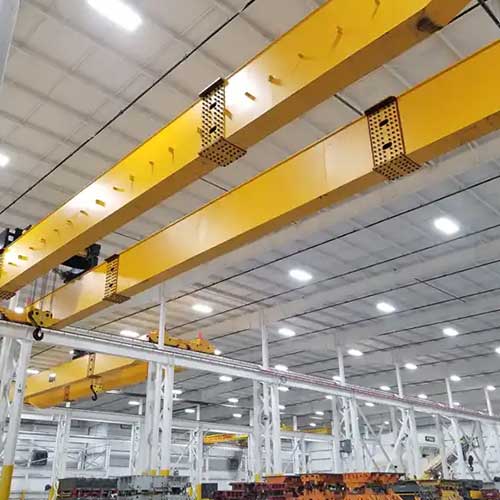
- Typical Types of Bridge Crane or Gantry Cranes Used: Gantry Cranes: Gantry cranes are suitable for handling conveyor components due to their flexibility and mobility.
- Functions in Conveyor System Handling: Installation:Overhead cranes assist in lifting and installing conveyor sections.Maintenance:Cranes facilitate maintenance tasks, such as replacing conveyor belts or components.
- Applications in Industrial Sectors: Widely used in manufacturing plants, warehouses, and distribution centers.
- Loads Handled: Conveyor sections, motors, rollers, and other components.
- Workshop or Site Installed: Cranes may be used both in workshops for conveyor system fabrication and on site for installation and maintenance.
Pipeline Installation:
Overview: Overhead cranes are utilized in the installation of steel pipelines within buildings. Whether it's for plumbing, HVAC systems, or other utilities, overhead cranes assist in lifting and positioning steel pipes into place. This application ensures the proper alignment and installation of pipelines throughout the building.

- Pipeline installation involves the lifting and positioning of steel pipes for plumbing, HVAC systems, or other utility purposes.
- Typical Types of Bridge Crane or Gantry Cranes Used: Bridge Cranes: Single or double girder bridge cranes are commonly used, depending on the size and weight of the pipes.
- Functions in Pipeline Installation: Lifting and Placement:Overhead cranes lift and position steel pipes for accurate installation. Precision Control:Precision control is crucial for aligning pipes and ensuring proper installation.
- Applications in Industrial Sectors: Found in various industries, including construction, manufacturing, and utilities.
- Loads Handled: Steel pipes of different diameters and lengths.
- Workshop or Site Installed: Cranes are used both in workshops for prefabrication and on site for the installation of pipelines.
Steel Façade Erection:
Overhead cranes are involved in the erection of steel façades, which are external architectural elements of a building. These cranes assist in lifting and installing large steel panels or components that form the exterior appearance of the building. The precision offered by overhead cranes is crucial in achieving the desired aesthetic and structural design.
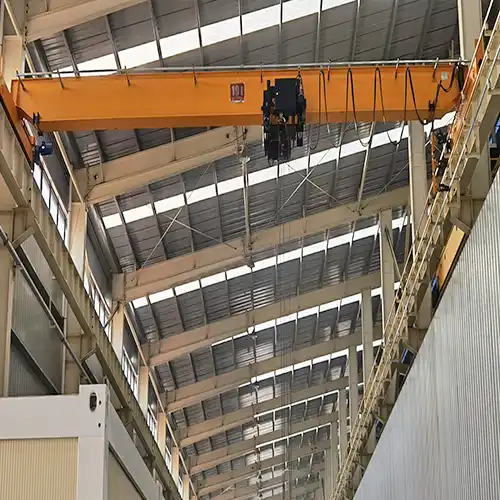
- Overview of Steel Façade Erection: Steel façade erection involves lifting and installing large steel panels or components that form the external appearance of a building.
- Typical Types of Bridge Crane or Gantry Cranes Used: Bridge Cranes: Single or double girder bridge cranes are suitable, depending on the size and weight of the façade components.
- Functions in Steel Façade Erection: . Lifting and Placement:Overhead cranes lift and precisely position steel panels or components for façade installation.Aesthetic Alignment:Cranes contribute to aligning façade elements to achieve the desired architectural design.
- Applications in Industrial Sectors: Primarily used in commercial and high rise building construction.
- Loads Handled: Large steel panels, cladding, and façade components.
- Workshop or Site Installed: Cranes are typically used on site during the construction phase for the erection of steel façades.
Steel Staircase Installation:
Overhead cranes are used in the installation of steel staircases within buildings. The cranes assist in lifting and positioning heavy steel components, ensuring the accurate assembly of staircases. This application is common in various types of buildings, including industrial facilities, commercial spaces, and residential structures.
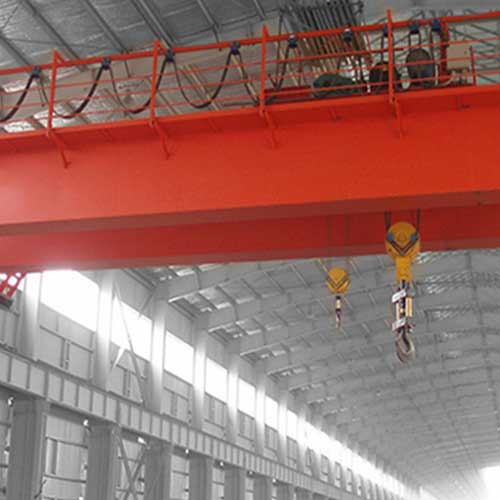
- Overview of Steel Staircase Installation: Steel staircase installation involves lifting and assembling steel components to create staircases within a building.
- Typical Types of Bridge Crane or Gantry Cranes Used: Bridge Cranes: Single or double girder bridge cranes are used, depending on the size and weight of staircase components.
- Functions in Steel Staircase Installation: Lifting and Assembly:Overhead cranes lift steel components, facilitating the precise assembly of staircases. Positioning:Cranes ensure accurate positioning of staircase elements.
- Applications in Industrial Sectors: Commonly found in various building types, including commercial and residential structures.
- Loads Handled: Steel stringers, treads, and railings.
- Workshop or Site Installed: Cranes may be used both in workshops for staircase fabrication and on site for installation.
Steel Frame Prefabrication:
Overhead cranes play a vital role in the prefabrication of steel frames used in building construction. These frames, which form the skeleton of a structure, are efficiently assembled off site and transported for installation. Overhead cranes facilitate the lifting, movement, and precise placement of steel frame components, contributing to the efficiency of the prefabrication process.
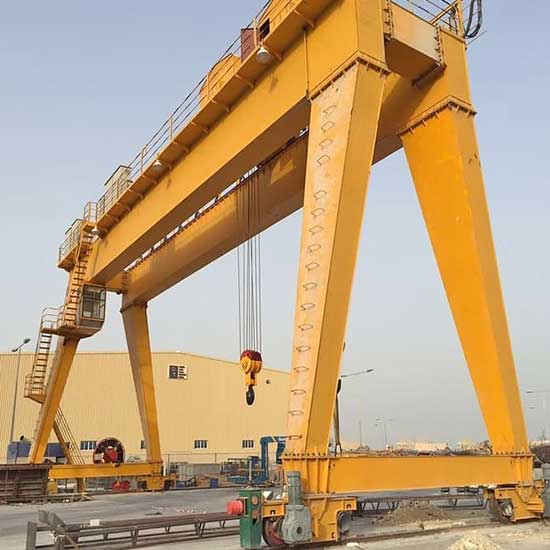
- Overview of Steel Frame Prefabrication: Steel frame prefabrication involves the off site fabrication of structural steel frames used in building construction.
- Typical Types of Bridge Crane or Gantry Cranes Used: Gantry Cranes: Gantry cranes are commonly used due to their flexibility and ability to cover large workshop areas.
- Functions in Steel Frame Prefabrication: Lifting and Movement:Overhead cranes lift and move steel frame components for assembly. Precise Placement:Cranes ensure precise placement of steel elements to create the frame.
- Applications in Industrial Sectors: Widely used in commercial and industrial construction.
- Loads Handled: Structural steel columns, beams, and other frame components.
- Workshop or Site Installed: Overhead cranes are primarily used in workshops for prefabricating steel frames.
Residential Steel Framing Assembly:
Overview: Overhead cranes are employed in the assembly of steel framing components for residential buildings. From lifting wall frames to positioning floor joists, overhead cranes contribute to the efficient and accurate assembly of steel framing elements. This application is prevalent in the construction of residential structures where steel framing offers strength and durability.
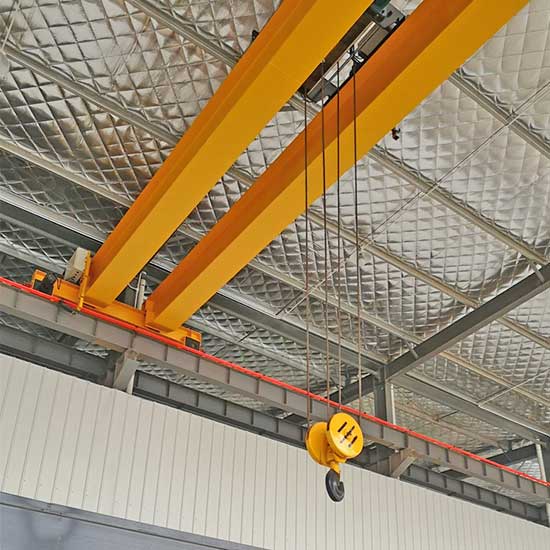
- Framing Assembly: Residential steel framing assembly involves the lifting and assembly of steel components to create the framework for residential structures.
- Typical Types of Bridge Crane or Gantry Cranes Used: Bridge Cranes: Single or double girder bridge cranes are used based on the size and weight of residential framing components.
- Functions in Residential Steel Framing Assembly: Lifting and Assembly:Overhead cranes lift steel components, facilitating the precise assembly of residential framing. Positioning:Cranes ensure accurate positioning of framing elements.
- Applications in Industrial Sectors: Primarily used in residential construction. Loads Handled: Steel studs, joists, and other framing components.
- Workshop or Site Installed: Cranes may be used both in workshops for residential framing fabrication and on site for installation.
Each of these applications showcases the versatility and efficiency of overhead cranes in various aspects of steel building construction. Their ability to handle heavy loads, provide precision control, and streamline the assembly process makes them indispensable in ensuring the success of diverse construction projects.
Advantages of Using Overhead Cranes in Steel Structure Handling
Efficiency and Time Savings
Overhead cranes play a pivotal role in enhancing efficiency and time savings in steel structure handling. The bridge and gantry cranes, equipped with high lifting capacities, expedite the movement of heavy components, significantly reducing the time required for assembly. Their ability to cover large spans swiftly ensures a streamlined workflow, contributing to overall project efficiency.
Precision and Accuracy
One of the standout advantages of overhead cranes is their precision and accuracy in handling steel structures. Double girder cranes, known for their stability, provide precise positioning of large and heavy components during installation. Telescopic cranes, with their extendable booms, allow for meticulous placement of steel elements at varying heights. This level of precision ensures structural integrity and minimizes the need for adjustments, leading to a smoother construction process.
Safety Considerations
Safety is paramount in construction, and overhead cranes are equipped with advanced safety features. Jib cranes, with their horizontal jibs and limit switches, offer safe and controlled movements within confined spaces. Smart technologies integrated into bridge cranes include collision avoidance systems, emergency stop mechanisms, and overload protection, ensuring a secure working environment. The commitment to safety enhances overall project reliability and minimizes the risk of accidents.
Versatility and Adaptability
The versatility of overhead cranes is a key advantage in handling diverse steel structures. Single girder cranes, being lightweight and agile, excel in navigating smaller spaces and adapting to changing construction requirements. Gantry cranes, with their ground level support, provide versatility in outdoor environments where overhead support might be challenging. The adaptability of these cranes ensures their applicability across a wide range of construction scenarios.
Cost effectiveness
Cost effectiveness is a critical consideration in construction projects, and overhead cranes offer economic benefits. Single girder cranes, being more economical in terms of initial investment and maintenance costs, provide a cost effective solution for handling lighter loads. Automation features in double girder cranes contribute to increased production efficiency, reducing labor costs in steel frame prefabrication. The overall cost effectiveness of overhead cranes makes them a strategic investment for construction projects with a focus on budget optimization.
In the next part of our guide, we will explore the crucial factors to consider when choosing the right overhead crane for specific construction needs. Understanding these factors will empower decision makers to make informed choices, ensuring the success of steel building projects. Stay tuned for valuable insights that will guide you in selecting the optimal overhead crane for your construction endeavors.
Choosing the Right Overhead Crane for Specific Applications
Factors to Consider
- Load Capacity -The load capacity is a fundamental factor in choosing the right overhead crane. Double girder cranes excel in heavy duty applications, providing the necessary strength to lift and maneuver substantial steel components. Understanding the weight requirements of your construction project ensures that the selected crane can handle the loads efficiently.
- Span Length -Span length, or the distance between the runways or supports, is crucial for determining the appropriate overhead crane. Gantry cranes, with their ground level support, are suitable for outdoor applications with longer spans. Evaluating the spatial requirements of your construction site ensures optimal crane performance and safety.
- Crane Speed -The speed of the crane is a consideration for achieving efficient and timely operations. Bridge cranes, known for their rapid traverse along elevated runways, enhance overall project speed. Assessing the required speed for load movement and positioning ensures that the selected crane aligns with the project's pace.
- Height and Lift -The height and lift requirements of a construction project influence the crane's design and specifications. Telescopic cranes, with their extendable booms, are well suited for tasks that involve varying heights. Understanding the vertical aspects of your project ensures that the crane can reach and lift components to the required elevations.
- Environmental Conditions -Environmental conditions, such as indoor or outdoor settings, impact the choice of overhead crane. Gantry cranes, adaptable to outdoor environments, provide ground level support, making them suitable for construction sites without existing overhead structures. Considering the environmental conditions ensures that the crane can operate effectively in the given context.
- Automation and Technology Integration -The integration of automation and technology features enhances crane performance and efficiency. Double girder cranes equipped with automation streamline processes in steel frame prefabrication. Assessing the technological requirements of your construction project ensures that the crane aligns with the desired level of automation and efficiency.
Purchasing a Steel Structure Handling Overhead Crane
Identifying Requirements
Before embarking on the purchase of a steel structure handling overhead crane, it is crucial to identify the specific requirements of your construction project. Consider factors such as load capacity, span length, height requirements, and the nature of steel components to be handled. Clearly defining your project's needs ensures that the selected crane aligns with the demands of the job, optimizing performance and efficiency.
Researching Manufacturers and Suppliers
Thorough research into reputable manufacturers and suppliers is paramount in ensuring the quality and reliability of your chosen overhead crane. Look for manufacturers with a proven track record in producing durable and high performance cranes. Consider customer reviews, industry reputation, and the availability of customized solutions to meet your project's unique requirements. A comprehensive understanding of the market ensures a well informed decision.
Considering Budgetary Constraints
Budget considerations play a significant role in the procurement process. Evaluate the costs associated with the purchase, installation, and potential modifications required for the overhead crane. Single girder cranes, known for their cost effectiveness, may be suitable for projects with lighter load requirements, while double girder cranes may offer greater benefits for heavy duty applications. Striking a balance between cost and performance ensures an optimal investment for your construction project.
Evaluating After Sales Support and Maintenance Services
Post purchase support and maintenance services are critical aspects of ensuring the long term functionality and reliability of your overhead crane. Research the after sales support provided by manufacturers, including warranty terms, technical assistance, and availability of spare parts. Additionally, assess the maintenance services offered, such as routine inspections, repairs, and upgrades. Choosing a supplier with robust after sales support contributes to the longevity and efficiency of your overhead crane throughout its operational life.
Crane Operation for Related indusrtrial sectors to Steel Strucutre Manufacturing
Several industrial sectors are closely related to steel structure handling in steel building construction. These sectors play integral roles in the overall process of designing, manufacturing, and erecting steel structures. Some of the key related industrial sectors include Steel Manufacturing, Steel Fabrication and Workshop Facilities, Construction and Engineering,4. Architectural Design and Planning,
Material Handling and Logistics, Technology and Automation,7. Safety and Complianc, 8. Real Estate Development,etc.
These sectors work collaboratively to bring steel building construction projects from conception to completion, each playing a crucial role in the successful implementation of steel structures.
Steel Manufacturing
Industrial Overview:Steel manufacturing involves the processing of raw steel through various stages, including smelting, casting, and rolling to produce steel products.
Types of Cranes Used:
Overhead Cranes: Utilized for transporting steel coils within the manufacturing plant.
Gantry Cranes: Used for handling large and heavy components during different stages of the steel manufacturing process.
Typical Crane Capacity:
Overhead Cranes: Varies based on the weight of steel coils.
Gantry Cranes: High load capacity to handle substantial steel components.
Typical Functions and Applications:
Overhead Cranes: Transporting steel coils between processing stages.
Gantry Cranes: Handling large and heavy components in casting areas and manufacturing processes.
Relation with Steel Structure Manufacturing:Overhead cranes and gantry cranes in steel manufacturing play a crucial role in handling and transporting raw materials, contributing to the overall efficiency of the manufacturing process.
Steel Fabrication and Workshop Facilities
Industrial Overview:Steel fabrication workshops are equipped with heavy duty machinery and welding stations for transforming raw steel into fabricated structural elements.
Types of Cranes Used:
Overhead Cranes: Positioned strategically for lifting and moving heavy steel beams and other large fabricated structures.
Gantry Cranes: Utilized for outdoor material handling, transporting steel components within the workshop yard.
Typical Crane Capacity:
Overhead Cranes: Tailored to lift and move large fabricated structures.
Gantry Cranes: High load capacity for handling outdoor material handling tasks.
Typical Functions and Applications:
Overhead Cranes: Lifting and moving large fabricated structures within the workshop.
Gantry Cranes: Transporting steel components in outdoor yards, optimizing material handling.
Relation with Steel Structure Manufacturing:Overhead cranes and gantry cranes in steel fabrication workshops facilitate the movement and positioning of fabricated components, contributing to efficient manufacturing processes.
Construction and Engineering
Industrial Overview:Construction and engineering involve the execution of construction projects based on architectural and engineering plans.
Types of Cranes Used:
Overhead Cranes: Ensuring proper installation and alignment of steel components on construction sites.
Typical Crane Capacity:
Overhead Cranes: Varied capacities based on construction project requirements.
Typical Functions and Applications:
Overhead Cranes: Installing and aligning steel components during construction projects.
Relation with Steel Structure Manufacturing:Overhead cranes in construction and engineering ensure the precise installation of steel components, contributing to the structural integrity of buildings.
Architectural Design and Planning
Industrial Overview:Architectural design and planning involve creating functional and aesthetically pleasing structures.
Types of Cranes Used:
No direct crane usage; collaboration with construction teams to integrate steel components seamlessly into the overall building design.
Typical Crane Capacity:
Not applicable.
Typical Functions and Applications:
Collaborating with construction teams to incorporate steel components into architectural designs.
Relation with Steel Structure Manufacturing:Architects work in collaboration with construction teams to ensure that steel components seamlessly integrate into the architectural design, contributing to the overall aesthetics and functionality of the structure.
Material Handling and Logistics
Industrial Overview:Material handling and logistics ensure the efficient transportation and delivery of steel components from manufacturing facilities to construction sites.
Types of Cranes Used:
Gantry Cranes: Managing the logistics of transporting large and heavy steel elements using specialized vehicles and equipment.
Typical Crane Capacity:
Gantry Cranes: High load capacity for handling large steel components.
Typical Functions and Applications:
Gantry Cranes: Transporting steel components efficiently for delivery and storage.
Relation with Steel Structure Manufacturing:Gantry cranes in material handling and logistics play a critical role in ensuring the organized and efficient transportation of steel components, optimizing the supply chain.
Technology and Automation
Industrial Overview:Technology and automation provide solutions for precision cutting, welding, and handling of steel components.
Types of Cranes Used:
Overhead Cranes: Equipped with smart technologies for precision handling.
Typical Crane Capacity:
Overhead Cranes: Varied capacities with integrated smart technologies.
Typical Functions and Applications:
Overhead Cranes: Implementing automation and smart technologies to enhance the efficiency and accuracy of steel structure manufacturing.
Relation with Steel Structure Manufacturing:Overhead cranes in technology and automation contribute to the adoption of smart technologies, optimizing the manufacturing process and ensuring precision in handling steel components
Safety and Compliance
Industrial Overview:Safety and compliance focus on implementing safety measures and adhering to industry regulations.
Types of Cranes Used:
Overhead Cranes: Equipped with safety features to ensure secure handling.
Typical Crane Capacity:
Overhead Cranes: Capacities aligned with safety standards.
Typical Functions and Applications:
Overhead Cranes: Prioritizing safety in the handling of steel components.
Relation with Steel Structure Manufacturing:Overhead cranes in safety and compliance play a crucial role in ensuring the safe handling and transportation of steel components, adhering to industry regulations.
Real Estate Development
Industrial Overview:Real estate development involves planning, designing, and constructing buildings for residential, commercial, or industrial purposes.
Types of Cranes Used:
Overhead Cranes: Utilized in the construction of various building structures.
Typical Crane Capacity:
Overhead Cranes: Varied capacities based on construction project requirements.
Typical Functions and Applications:
Overhead Cranes: Installing steel components during the construction of real estate projects.
Relation with Steel Structure Manufacturing:Overhead cranes in real estate development contribute to the construction of buildings, ensuring the proper installation and alignment of steel components.
Conclusion
Making informed decisions in the selection and utilization of overhead cranes is paramount to the success of construction projects. Understanding the specific needs of a project, considering technological advancements, and aligning with sustainable practices contribute to efficient and streamlined construction processes.
As we look ahead, the future of overhead crane technology holds exciting possibilities. Advancements in automation, robotics, connectivity, sustainability, and integration with digital models will revolutionize the construction landscape. Envisioning this future encourages industry professionals to stay at the forefront of innovation, embracing technologies that enhance efficiency, safety, and sustainability.
In conclusion, the world of steel structure handling overhead cranes is dynamic and evolving. This guide serves as a valuable resource for construction professionals, engineers, and decision makers, providing insights into the present and a glimpse into the future. Elevate your construction excellence by leveraging the power of overhead cranes in building the structures of tomorrow.
Main Projects
Related Products

Supplied three grab bucket crane kits to Indonesia, enhancing garbage handling efficiency with high load capacity and reliable performance.
Free consultation to Confirm Parameters & Specifications and Get
Latest Crane Price & Crane Rate.
- Types of overhead cranes : _______?
- Optional: Overhead travelling crane, goliath gantry crane,Slewing jib crane, Single girder or double girder crane,small portable crane or kbk crane, etc.
- Capacity of overhead crane: _______?
- Optional: 0.25ton, 0.5 ton, 1 ton, 2 ton, 3ton, 5 ton, 10 ton,15ton, 20ton, 25 ton, 30ton,35ton, up to 550ton, etc.
- Crane span & lifting height : _______?
- Crane travelling length : _____?
- Control of overhead crane:_______?
- Optional: pendant/ remote/cabin control
- Voltage supply of overhead crane:_____?
- Eg,: 380V50/60HZ,3Phase or others,etc.
- Application/usage of crane:_______?
- Eg,: Steel mill, ,injection mold, cement,stone, concrete,granite, general manufacturing, etc.
Just leave a message via the contact form and our hoist and crane engineer will contact you with in 24working hours.
Get In Touch
